What Effect Does The Agricultural Industry Have On Climate Change?
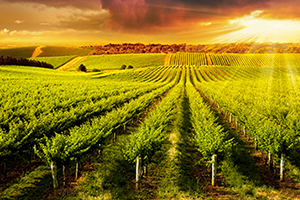 On This Page:
On This Page:
- Overview
- Impacts on Crops
- Impacts on Livestock
- Impacts on Fisheries
- International Impacts
Overview
Agriculture is an important sector of the U.S. economic system. The crops, livestock, and seafood produced in the United States contribute more than $300 billion to the economy each twelvemonth.[1] When food-service and other agriculture-related industries are included, the agricultural and food sectors contribute more than $750 billion to the gross domestic product.[2]
Agriculture and fisheries are highly dependent on the climate. Increases in temperature and carbon dioxide (CO2) tin can increment some crop yields in some places. Merely to realize these benefits, nutrient levels, soil wet, h2o availability, and other conditions must also be met. Changes in the frequency and severity of droughts and floods could pose challenges for farmers and ranchers and threaten nutrient safe.[3] Meanwhile, warmer water temperatures are likely to cause the habitat ranges of many fish and shellfish species to shift, which could disrupt ecosystems. Overall, climate change could make it more hard to grow crops, enhance animals, and catch fish in the aforementioned ways and aforementioned places as nosotros have done in the past. The furnishings of climate change also need to exist considered along with other evolving factors that affect farm production, such as changes in farming practices and technology.
Impacts on Crops
Click the image to view a larger version. 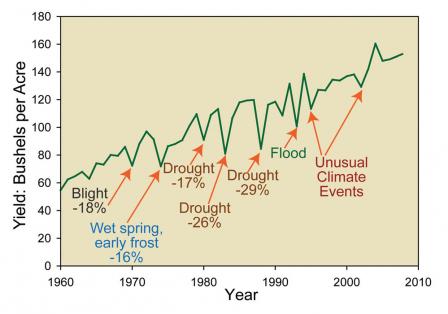 Despite technological improvements that increase corn yields, extreme weather events take caused significant yield reductions in some years. Source: USGCRP (2009)
Despite technological improvements that increase corn yields, extreme weather events take caused significant yield reductions in some years. Source: USGCRP (2009)
Crops grown in the United States are critical for the food supply hither and around the world. U.S. farms supply nearly 25% of all grains (such equally wheat, corn, and rice) on the global market place.[iv] Changes in temperature, atmospheric carbon dioxide (CO2), and the frequency and intensity of extreme weather could have significant impacts on crop yields.
For whatsoever particular crop, the effect of increased temperature will depend on the crop's optimal temperature for growth and reproduction.[ane] In some areas, warming may benefit the types of crops that are typically planted there, or let farmers to shift to crops that are currently grown in warmer areas. Conversely, if the higher temperature exceeds a crop's optimum temperature, yields volition decline.
- Higher COii levels can affect crop yields. Some laboratory experiments suggest that elevated CO2 levels can increment plant growth. However, other factors, such as changing temperatures, ozone, and water and nutrient constraints, may counteract these potential increases in yield. For example, if temperature exceeds a crop'south optimal level, if sufficient h2o and nutrients are non available, yield increases may be reduced or reversed. Elevated COtwo has been associated with reduced poly peptide and nitrogen content in alfalfa and soybean plants, resulting in a loss of quality. Reduced grain and forage quality can reduce the power of pasture and rangeland to back up grazing livestock. [1]
- More extreme temperature and precipitation can preclude crops from growing. Farthermost events, particularly floods and droughts, can impairment crops and reduce yields. For example, in 2010 and 2012, high dark temperatures affected corn yields across the U.Southward. Corn Belt, and premature budding due to a warm winter caused $220 1000000 in losses of Michigan cherries in 2012.[1]
- Dealing with drought could become a challenge in areas where rising summer temperatures crusade soils to become drier. Although increased irrigation might be possible in some places, in other places water supplies may too exist reduced, leaving less water available for irrigation when more is needed.
- Many weeds, pests, and fungi thrive under warmer temperatures, wetter climates, and increased CO2 levels. Currently, U.S. farmers spend more than $11 billion per year to fight weeds, which compete with crops for light, water, and nutrients. [ane] The ranges and distribution of weeds and pests are likely to increase with climatic change. This could cause new bug for farmers' crops previously unexposed to these species.
- Though rising COtwo can stimulate plant growth, information technology also reduces the nutritional value of most food crops. Rise levels of atmospheric carbon dioxide reduce the concentrations of poly peptide and essential minerals in most plant species, including wheat, soybeans, and rice. This directly effect of rising CO2 on the nutritional value of crops represents a potential threat to human health. Human health is also threatened by increased pesticide use due to increased pest pressures and reductions in the efficacy of pesticides.[3]
Top of Page
Impacts on Livestock
Click the image to view a larger version. 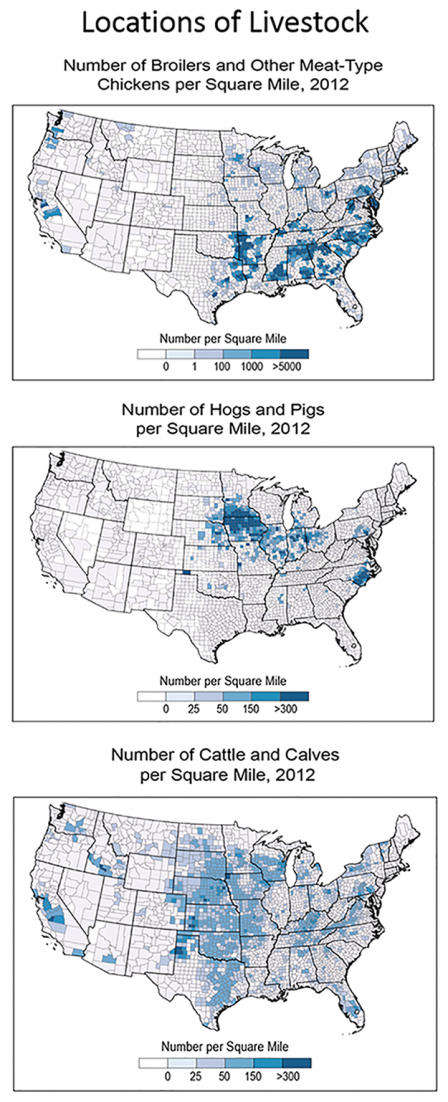 Livestock locations in the continental United States. Source: USGCRP (2016)
Livestock locations in the continental United States. Source: USGCRP (2016)
- Heat waves, which are projected to increase under climate change, could direct threaten livestock. In 2011, exposure to high temperature events acquired over $i billion in heat-related losses to agricultural producers.[one] Heat stress affects animals both straight and indirectly. Over fourth dimension, heat stress can increase vulnerability to affliction, reduce fertility, and reduce milk production.
- Drought may threaten pasture and feed supplies. Drought reduces the amount of quality forage bachelor to grazing livestock. Some areas could feel longer, more intense droughts, resulting from higher summertime temperatures and reduced precipitation. For animals that rely on grain, changes in crop production due to drought could also become a problem.
- Climate change may increase the prevalence of parasites and diseases that touch livestock. The before onset of bound and warmer winters could allow some parasites and pathogens to survive more easily. In areas with increased rainfall, moisture-reliant pathogens could thrive.[6]
- Potential changes in veterinary practices, including an increase in the utilize of parasiticides and other brute health treatments, are likely to exist adopted to maintain livestock health in response to climate-induced changes in pests, parasites, and microbes. This could increment the chance of pesticides entering the food chain or lead to evolution of pesticide resistance, with subsequent implications for the safe, distribution, and consumption of livestock and aquaculture products.[3]
- Increases in carbon dioxide (COtwo) may increment the productivity of pastures, but may also decrease their quality. Increases in atmospheric CO2 can increase the productivity of plants on which livestock feed. All the same, the quality of some of the forage found in pasturelands decreases with higher CO2. As a issue, cattle would need to eat more to get the aforementioned nutritional benefits.
Summit of Page
Impacts on Fisheries
American fishermen catch or harvest five million metric tons of fish and shellfish each year.[7] U.S. fisheries contribute more than than $one.55 billion to the economy annually (equally of 2012).[8] Many fisheries already face multiple stresses, including overfishing and h2o pollution. Climatic change may worsen these stresses. In particular, temperature changes could atomic number 82 to significant impacts.
Click the epitome to view a larger version. 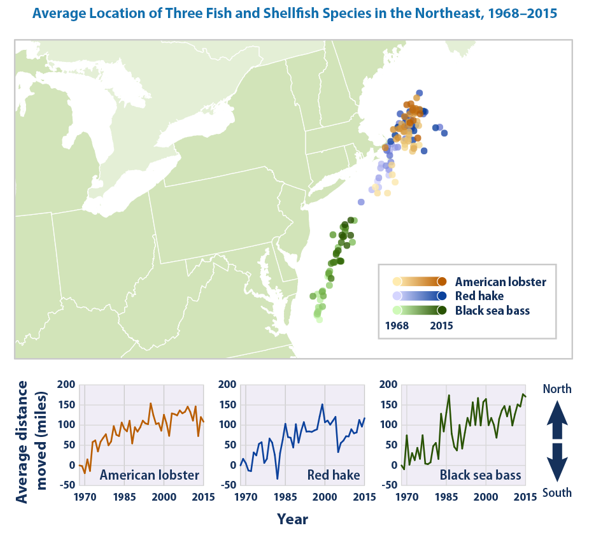 This map shows the almanac centers of biomass for iii species in the northeastern United States from 1968 to 2015. Dots are shaded from calorie-free to dark to testify change over time. Source: U.s.a. EPA (2016). Climatic change Indicators in the United states: Marine Species Distribution. Information Source: NOAA (2016). OceanAdapt.Leave
This map shows the almanac centers of biomass for iii species in the northeastern United States from 1968 to 2015. Dots are shaded from calorie-free to dark to testify change over time. Source: U.s.a. EPA (2016). Climatic change Indicators in the United states: Marine Species Distribution. Information Source: NOAA (2016). OceanAdapt.Leave
- Many aquatic species can find colder areas of streams and lakes or move north along the coast or in the bounding main. Nevertheless, moving into new areas may put these species into competition with other species over food and other resources, as explained on the Ecosystems Impacts page.
- Some marine illness outbreaks have been linked with changing climate. Higher water temperatures and higher estuarine salinities have enabled an oyster parasite to spread farther northward along the Atlantic declension. Winter warming in the Arctic is contributing to salmon diseases in the Bering Body of water and a resulting reduction in the Yukon Chinook Salmon, Finally, warmer temperatures take caused disease outbreaks in coral, eelgrass, and abalone.[3],[10]
- Changes in temperature and seasons can affect the timing of reproduction and migration. Many steps within an aquatic animal'southward lifecycle are controlled by temperature and the irresolute of the seasons. For example, in the Northwest warmer water temperatures may bear on the lifecycle of salmon and increase the likelihood of disease. Combined with other climate impacts, these effects are projected to lead to large declines in salmon populations.[1],[11],[12]
In addition to warming, the earth's oceans are gradually condign more acidic due to increases in atmospheric carbon dioxide (CO2). Increasing acidity could damage shellfish by weakening their shells, which are created past removing calcium from seawater. [10] Acidification also threatens the structures of sensitive ecosystems upon which some fish and shellfish rely. [one],[13]
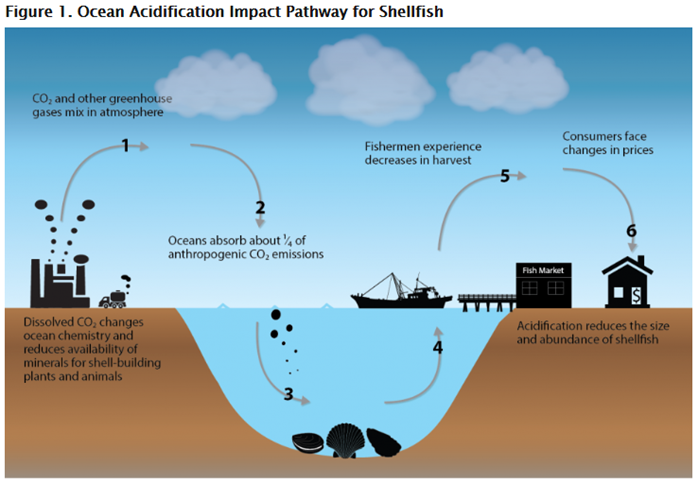 This diagram shows the impact pathway of carbon dioxide emissions on the shellfish market. Carbon dioxide is absorbed past oceans, resulting in ocean acidification. Acidification reduces the size and abundance of shellfish, which in turn leads to decreased harvest and eventually to changes in prices for consumers. Source: United states EPA (2015). Climate change in the United States: Benefits of Global Action
This diagram shows the impact pathway of carbon dioxide emissions on the shellfish market. Carbon dioxide is absorbed past oceans, resulting in ocean acidification. Acidification reduces the size and abundance of shellfish, which in turn leads to decreased harvest and eventually to changes in prices for consumers. Source: United states EPA (2015). Climate change in the United States: Benefits of Global Action
International Impacts
Climate change is very likely to affect food security at the global, regional, and local level. Climate change can disrupt food availability, reduce admission to nutrient, and affect food quality.[14] For case, projected increases in temperatures, changes in precipitation patterns, changes in extreme weather events, and reductions in water availability may all result in reduced agronomical productivity. Increases in the frequency and severity extreme weather events tin can also interrupt food delivery, and resulting spikes in food prices after extreme events are expected to exist more than frequent in the hereafter. Increasing temperatures can contribute to spoilage and contagion.
Internationally, these effects of climate change on agriculture and nutrient supply are probable to be like to those seen in the United States. However, other stressors such every bit population growth may magnify the effects of climate change on food security. In developing countries, adaptation options like changes in crop-management or ranching practices, or improvements to irrigation are more express than in the Us and other industrialized nations.
Whatever climate-related disturbance to nutrient distribution and transport, internationally or domestically, may have meaning impacts non only on prophylactic and quality but as well on nutrient access. For example, the food transportation arrangement in the U.s. frequently moves large volumes of grain by water. In the case of an extreme weather consequence affecting a waterway, at that place are few, if any, alternate pathways for transport. High temperatures and a shortage of rain in the summer of 2012 led to one of the most severe summer droughts the nation has seen and posed serious impacts to the Mississippi River watershed, a major transcontinental shipping route for Midwestern agriculture. This drought resulted in significant food and economic losses due to reductions in clomp traffic, the volume of goods carried, and the number of Americans employed by the tugboat industry. The 2012 drought was immediately followed past flooding throughout the Mississippi in the spring of 2013, which likewise resulted in disruptions of clomp traffic and nutrient transport.[three] Transportation changes such as these reduce the ability of farmers to consign their grains to international markets, and can bear upon global food prices.
Impacts to the global food supply business organization the United States because food shortages tin cause humanitarian crises and national security concerns. They also can increase domestic food prices.
Peak of Page
References
[1] USGCRP (2014). Hatfield, J., Thou. Takle, R. Grotjahn, P. Holden, R. C. Izaurralde, T. Mader, E. Marshall, and D. Liverman, 2014: Ch. six: Agricivilisation. Climatic change Impacts in the Us: The 3rd National Climate Assessment, J. One thousand. Melillo, Terese (T.C.) Richmond, and Grand. W. Yohe, Eds., U.S. Global Change Research Program, 150-174.
[2] USDA (2016). Economical Research Service, undated.What is Agronomics's Share of the Overall US Economy?
[three]USGCRP (2014).Ziska, L., A. Crimmins, A. Auclair, South. DeGrasse, J.F. Garofalo, A.South. Khan, I. Loladze, A.A. Pérez de León, A. Showler, J. Thurston, and I. Walls, 2016: Ch. 7: Food Rubber, Nutrition, and Distribution. The Impacts of Climate change on Human Health in the U.s.a.: A Scientific Assessment. U.Due south. Global Change Research Program, Washington, DC, 189–216.
[4] USDA (2015). World Agronomics Supply and Need Estimates. U.Southward. Section of Agriculture.
[5] USDA (2016). Economic Inquiry Service. Animal Production & Marketing Issues.
[6] CCSP (2008). The Effects of Climate Change on Agronomics, Country Resources, Water Resource, and Biodiversity in the United States. A Report by the U.Southward. Climate Change Scientific discipline Program and the Subcommittee on Global Change Research. Backlund, P., A. Janetos, D. Schimel, J. Hatfield, K. Boote, P. Fay, L. Hahn, C. Izaurralde, B.A. Kimball, T. Mader, J. Morgan, D. Ort, W. Polley, A. Thomson, D. Wolfe, Grand. Ryan, S. Archer, R. Birdsey, C. Dahm, L. Heath, J. Hicke, D. Hollinger, T. Huxman, Thou. Okin, R. Oren, J. Randerson, West. Schlesinger, D. Lettenmaier, D. Major, L. Poff, Southward. Running, L. Hansen, D. Inouye, B.P. Kelly, L Meyerson, B. Peterson, and R. Shaw. U.South. Environmental Protection Agency, Washington, DC, USA.
[7] NOAA (2014). National Marine Fisheries Service.Fisheries of the United states, 2014. NOAA Current Fishery Statistics No. 2014.
[8] USDA (2012). 2012 Census of Agriculture: Book 1, Chapter 1: U.S. National Level Data, Table 33. U.Southward. Department of Agronomics.
[9] US EPA (2016).Climatic change Indicators in the Us: A Closer Expect: Marine Species Distribution.
[10] USGCRP (2014).Doney, Southward., A. A. Rosenberg, M. Alexander, F. Chavez, C. D. Harvell, G. Hofmann, Thou. Orbach, and K. Ruckelshaus, 2014: Ch. 24: Oceans and Marine Resources. Climate Change Impacts in the United States: The Third National Climate Cess, J. G. Melillo, Terese (T.C.) Richmond, and G. W. Yohe, Eds., U.Due south. Global Alter Research Program, 557-578. doi:10.7930/J0RF5RZW.
[11] CCSP (2008). Preliminary Review of Adaptation Options for Climate-Sensitive Ecosystems and Resource. A Study by the U.Due south. Climate Change Science Plan and the Subcommittee on Global Change Research. Affiliate 3. Julius, S.H., J.M. West (eds.), J.S. Baron, B. Griffith, L.A. Joyce, P. Kareiva, B.D. Keller, Thou.A. Palmer, C.H. Peterson, and J.Thousand. Scott (authors). U.S. Ecology Protection Agency, Washington, DC, USA.
[12] IPCC (2014).Romero-Lankao, P., J.B. Smith, D.J. Davidson, N.S. Diffenbaugh, P.L. Kinney, P. Kirshen, P. Kovacs, and L. Villers Ruiz, 2014: North America. In: Climatic change 2014: Impacts, Adaptation, and Vulnerability. Part B: Regional Aspects. Contribution of Working Grouping 2 to the 5th Assessment Written report of the Intergovernmental Console on Climate Modify [Barros, 5.R., C.B. Field, D.J. Dokken, Thou.D. Mastrandrea, K.J. Mach, T.E. Bilir, M. Chatterjee, K.50. Ebi, Y.O. Estrada, R.C. Genova, B. Girma, E.Due south. Kissel, A.N. Levy, Due south. MacCracken, P.R. Mastrandrea, and L.50. White (eds.)]. Cambridge University Press, Cambridge, United Kingdom and New York, NY, Usa, pp. 1439-1498.
[13] US EPA (2015). Climate Modify in the United states of america: Benefits of Global Action: Shellfish.
[14] USDA (2015).Brown, One thousand.E., J.1000. Antle, P. Backlund, E.R. Carr, W.E. Easterling, M.One thousand. Walsh, C. Ammann, W. Attavanich, C.B. Barrett, M.F. Bellemare, V. Dancheck, C. Funk, Chiliad. Grace, J.S.I. Ingram, H. Jiang, H. Maletta, T. Mata, A. Murray, G. Ngugi, D. Ojima, B. O'Neill, and C. Tebaldi. 2015. Climate Change, Global Food Security, and the U.Southward. Food System. 146 pages.
Top of Page
Source: https://19january2017snapshot.epa.gov/climate-impacts/climate-impacts-agriculture-and-food-supply_.html
Posted by: woodsbobviscep.blogspot.com


0 Response to "What Effect Does The Agricultural Industry Have On Climate Change?"
Post a Comment